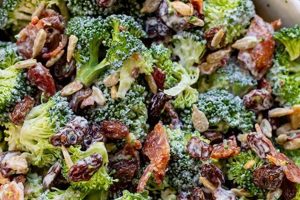Combining the nutritional powerhouses of broccoli and cauliflower, these salads offer a versatile and healthful culinary experience. They typically incorporate raw or blanched florets, often accompanied by other vegetables, dried fruits, nuts, seeds, and a flavorful dressing. Variations range from simple vinaigrettes to creamy, mayonnaise-based dressings, catering to diverse palates and dietary preferences. An example might include blanched broccoli and cauliflower, dried cranberries, sunflower seeds, and a lemon-tahini dressing.
Cruciferous vegetables like broccoli and cauliflower are rich in vitamins, minerals, and fiber, contributing to improved digestion, boosted immunity, and reduced risk of chronic diseases. These salads provide a refreshing and palatable way to incorporate these essential nutrients into one’s diet, particularly appealing during warmer months. Historically, while individual components have long been dietary staples, the concept of combining these vegetables specifically in salad form reflects more recent culinary trends emphasizing fresh, healthy, and convenient meal options.
This exploration will delve into the diverse world of these salads, examining popular variations, nutritional benefits, preparation techniques, and creative serving suggestions. From classic recipes to innovative twists, the aim is to provide a comprehensive resource for anyone seeking to incorporate these healthy and delicious salads into their meal planning.
Tips for Broccoli and Cauliflower Salads
Maximizing flavor and nutritional value requires attention to preparation techniques and ingredient selection. The following tips offer guidance for creating exceptional salads.
Tip 1: Blanching for Optimal Texture: Briefly submerging florets in boiling water, followed by an immediate ice bath, enhances color and tenderness while maintaining a crisp texture. This technique prevents overcooking and ensures a pleasant mouthfeel.
Tip 2: Dressing Selection: The dressing significantly influences the overall flavor profile. Lighter vinaigrettes complement the natural flavors of the vegetables, while creamy dressings add richness. Consider flavor pairings, such as lemon-tahini, honey-mustard, or a classic ranch.
Tip 3: Incorporating Textural Variety: Nuts, seeds, and dried fruits add contrasting textures and complementary flavors. Toasted almonds, sunflower seeds, or dried cranberries provide satisfying crunch and subtle sweetness.
Tip 4: Enhancing Flavor with Herbs and Spices: Fresh herbs like parsley, dill, or mint elevate the flavor profile. A pinch of red pepper flakes adds a subtle kick. Experimentation with different spice combinations can create unique and flavorful salads.
Tip 5: Proper Storage for Freshness: Storing the salad components separately and combining them just before serving maintains optimal freshness and prevents the vegetables from becoming soggy. Dressings should also be stored separately and added just before consumption.
Tip 6: Balancing Flavors: Consider the balance of sweet, savory, acidic, and crunchy elements. A touch of sweetness from dried fruit can be balanced by the tanginess of a vinaigrette and the saltiness of nuts or cheese.
Tip 7: Creative Ingredient Combinations: Explore a variety of ingredients beyond the basics. Roasted chickpeas, crumbled bacon, or chopped bell peppers can add depth and complexity to the salad.
By following these tips, one can create flavorful, nutritious, and visually appealing salads that showcase the versatility of broccoli and cauliflower.
In conclusion, these insights offer a foundation for crafting exceptional broccoli and cauliflower salads. Experimentation with different ingredients and techniques allows for endless possibilities and culinary creativity.
1. Ingredient Selection
Ingredient selection forms the foundation of successful broccoli and cauliflower salad recipes. The quality, freshness, and variety of ingredients directly impact the final dish’s flavor, texture, and nutritional value. Careful consideration of each component contributes to a well-balanced and satisfying salad.
- Fresh Produce Quality
Prioritizing fresh, high-quality broccoli and cauliflower is paramount. Look for firm, compact heads with vibrant color and no signs of browning or wilting. These visual cues indicate optimal freshness and contribute to better flavor and texture in the finished salad. Compromised produce can negatively impact the overall quality of the dish.
- Complementary Flavor Pairings
Thoughtful selection of additional ingredients enhances the flavor profile. Dried fruits, such as cranberries or raisins, offer sweetness and chewiness. Nuts and seeds, like toasted almonds or sunflower seeds, provide crunch and healthy fats. Sharp cheeses, such as crumbled feta or goat cheese, contribute a tangy, salty element. These additions create a complex and well-rounded flavor experience.
- Textural Variety
Incorporating ingredients with varying textures elevates the sensory experience. Crispy elements like raw vegetables (e.g., bell peppers, carrots) or toasted nuts contrast with the softer texture of the broccoli and cauliflower. This contrast creates a more dynamic and enjoyable mouthfeel.
- Nutritional Considerations
Ingredient choices can be tailored to meet specific dietary needs and preferences. Incorporating lean proteins, such as grilled chicken or chickpeas, adds satiety and nutritional value. Choosing a variety of colorful vegetables increases the range of vitamins and minerals. Awareness of ingredient composition allows for customization and optimization of nutritional content.
Strategic ingredient selection ultimately determines the success of a broccoli and cauliflower salad recipe. By focusing on fresh produce, complementary flavors, textural variety, and nutritional considerations, one can create a delicious and healthful dish that satisfies both the palate and the body’s nutritional needs. These choices elevate the salad from a simple side dish to a complete and fulfilling meal.
2. Blanching Techniques
Blanching plays a crucial role in broccoli and cauliflower salad recipes, impacting both texture and visual appeal. This technique involves briefly submerging vegetables in boiling water, then immediately transferring them to an ice bath to halt the cooking process. Proper blanching enhances the vibrancy of the vegetables while maintaining a desirable crisp-tender texture, essential for a successful salad.
- Timing and Temperature Precision
Precise timing and temperature control are paramount for optimal results. Over-blanching leads to mushy vegetables, while under-blanching results in a raw, unpleasant texture. Broccoli and cauliflower require slightly different blanching times due to their varying densities. Adhering to specific timeframes ensures the desired texture and preserves nutrients.
- Preserving Color and Nutrients
Blanching not only improves texture but also enhances the vibrant green of broccoli and the bright white of cauliflower. The brief exposure to heat sets the color, making the salad visually appealing. Furthermore, the rapid heating and cooling process minimizes nutrient loss, preserving the inherent health benefits of these cruciferous vegetables.
- Enhancing Flavor and Reducing Bitterness
Blanching can subtly enhance the natural flavors of broccoli and cauliflower while reducing any potential bitterness. The brief cooking process deactivates enzymes that contribute to bitterness, resulting in a more palatable and enjoyable flavor profile in the salad.
- Improving Food Safety
Blanching contributes to food safety by reducing the risk of bacterial contamination. The brief exposure to high temperatures helps eliminate potential pathogens, ensuring a safer and healthier salad. This is particularly important when using raw vegetables in a salad.
Mastering blanching techniques elevates broccoli and cauliflower salad recipes from simple to exceptional. By precisely controlling timing and temperature, optimizing color and nutrients, enhancing flavor, and improving food safety, blanching transforms raw vegetables into vibrant, flavorful, and texturally pleasing components, essential for a truly satisfying and healthy salad experience.
3. Dressing Choices
Dressing choices significantly influence the overall flavor profile and character of broccoli and cauliflower salads. The right dressing complements the vegetables’ natural flavors while adding depth and complexity. From light and tangy vinaigrettes to rich and creamy emulsions, the selection impacts not only taste but also texture and nutritional value. Understanding the interplay between dressing and salad components is essential for creating a harmonious and satisfying culinary experience.
- Vinaigrettes: Light and Zesty
Vinaigrettes, typically composed of oil and vinegar, offer a light and refreshing counterpoint to the cruciferous vegetables. The acidity of the vinegar cuts through the subtle sweetness of the vegetables, while the oil provides a smooth mouthfeel. Variations incorporating lemon juice, Dijon mustard, or herbs like dill or oregano add complexity. A simple lemon-herb vinaigrette enhances the natural flavors without overpowering them.
- Creamy Dressings: Rich and Indulgent
Creamy dressings, often based on mayonnaise, yogurt, or sour cream, provide a richer, more indulgent experience. These dressings coat the vegetables, adding a layer of flavor and creating a more substantial salad. Incorporating herbs, spices, or roasted garlic elevates the flavor profile. A Greek yogurt-based dressing with dill and lemon zest complements the vegetables while offering a lighter alternative to traditional mayonnaise-based dressings.
- Nut-Based Dressings: Earthy and Flavorful
Nut-based dressings, such as tahini or cashew cream dressings, offer a unique, earthy dimension. These dressings provide a creamy texture and distinct flavor profile that complements the cruciferous vegetables. Adding ingredients like lemon juice, maple syrup, or ginger creates a balanced and complex flavor. A tahini-based dressing with lemon and garlic provides a robust and flavorful coating for the salad.
- Flavor Pairings and Balance
Careful consideration of flavor pairings is crucial when selecting a dressing. The dressing should complement the other ingredients in the salad, creating a harmonious balance of flavors. For instance, a sweet and tangy vinaigrette pairs well with dried fruit and nuts, while a creamy dressing complements roasted vegetables or cheese. A well-balanced dressing elevates the overall flavor profile of the salad, ensuring a satisfying culinary experience.
The choice of dressing is integral to the overall success of a broccoli and cauliflower salad. By understanding the nuances of different dressing types and considering flavor pairings, one can create a salad that is not only delicious but also texturally and nutritionally balanced. The dressing serves as a unifying element, bringing together the diverse ingredients into a cohesive and satisfying whole.
4. Textural Variety
Textural variety elevates broccoli and cauliflower salad recipes from simple to sophisticated, engaging the palate beyond basic tastes. The inherent textures of broccoli and cauliflowerslightly firm florets with tender stemsprovide a foundational textural element. However, incorporating diverse textures creates a more dynamic and satisfying sensory experience. This interplay of textures enhances enjoyment and encourages mindful consumption.
Consider the addition of toasted nuts or seeds. Their crispness contrasts with the softer vegetables, introducing a pleasurable counterpoint. Toasted almonds, sunflower seeds, or pumpkin seeds offer distinct flavors and textures, adding complexity to each bite. Similarly, dried fruits, such as cranberries, raisins, or chopped apricots, contribute a chewy texture and subtle sweetness, further diversifying the sensory experience. Even the choice of dressing influences texture. A creamy dressing coats the vegetables, adding a smooth element, while a vinaigrette offers a lighter, more distinct textural contrast.
The practical significance of incorporating textural variety extends beyond mere enjoyment. The contrasting textures encourage more thorough chewing, aiding digestion. Furthermore, the interplay of textures makes the salad more visually appealing, enhancing its overall presentation. This attention to textural detail elevates the dish, transforming it from a basic side to a culinary centerpiece. Thoughtful incorporation of diverse textures demonstrates culinary expertise and enhances the dining experience, contributing to a more satisfying and memorable meal.
5. Flavor Balancing
Flavor balancing is paramount in broccoli and cauliflower salad recipes. It transforms a collection of ingredients into a harmonious, palatable dish. This involves strategically combining contrasting yet complementary tastessweet, sour, salty, bitter, and umamito create a well-rounded flavor profile. The inherent mildness of broccoli and cauliflower provides a neutral canvas, allowing for a wider range of flavor combinations. A successful recipe relies on the interplay of these flavors to avoid monotony and enhance enjoyment. For instance, the slight bitterness of raw broccoli can be offset by the sweetness of dried cranberries or a tangy vinaigrette. The addition of salty elements, such as toasted nuts or feta cheese, further enhances the complexity. Without proper balance, one flavor might dominate, overpowering the others and resulting in a less satisfying experience.
Consider a recipe featuring roasted broccoli and cauliflower, toasted pecans, crumbled goat cheese, and a honey-mustard vinaigrette. The roasting process intensifies the natural sweetness of the vegetables, while the pecans contribute a nutty richness and satisfying crunch. The tangy goat cheese adds a salty, acidic element, balanced by the sweetness and subtle sharpness of the honey-mustard vinaigrette. This interplay of flavors creates a complex and enjoyable salad that exemplifies flavor balancing. Conversely, a salad with only raw vegetables and a simple vinaigrette, while healthy, might lack the depth and complexity achieved through flavor balancing. Such a salad could benefit from the addition of contrasting flavors and textures, like dried fruit, toasted seeds, or a sprinkle of flavorful cheese.
Understanding flavor balancing empowers recipe development and elevates the culinary experience. It allows for creative ingredient combinations that enhance the natural flavors of broccoli and cauliflower, transforming a simple salad into a memorable dish. Successfully balancing these flavors ensures each bite offers a complex and satisfying interplay of tastes, creating a well-rounded and enjoyable culinary experience.
Frequently Asked Questions
This section addresses common inquiries regarding broccoli and cauliflower salad recipes, providing clear and concise information to assist culinary endeavors.
Question 1: How can bitterness in raw broccoli and cauliflower be mitigated in a salad?
Blanching the florets briefly in boiling water, followed by an immediate ice bath, reduces bitterness while enhancing color and maintaining crispness. Alternatively, marinating the raw vegetables in a flavorful dressing for a short period can also mellow the flavor.
Question 2: What are effective strategies for preventing a soggy salad?
Storing the salad components separately and combining them just before serving is crucial. Dressings should also be added immediately prior to consumption. Avoid over-dressing, as excess moisture contributes to sogginess.
Question 3: How can these salads be made more substantial for a complete meal?
Adding protein-rich ingredients such as grilled chicken, chickpeas, or hard-boiled eggs transforms the salad into a satisfying main course. Incorporating grains like quinoa or farro further enhances satiety and nutritional value.
Question 4: What are suitable alternatives for individuals with nut allergies?
Sunflower seeds, pumpkin seeds, or roasted chickpeas offer similar textural and nutritional benefits without the allergenic concerns associated with nuts. These alternatives provide a satisfying crunch and contribute to a well-rounded salad.
Question 5: Can these salads be prepared in advance for meal prepping?
While components can be prepared ahead of timevegetables blanched, other ingredients choppedit’s recommended to combine and dress the salad just before serving to maintain optimal freshness and prevent sogginess. Store components separately in airtight containers.
Question 6: How can the nutritional value of these salads be maximized?
Incorporating a variety of colorful vegetables, such as bell peppers, carrots, or red onion, increases the range of vitamins and minerals. Adding lean protein and healthy fats further enhances the nutritional profile, creating a more complete and balanced meal.
Understanding these key aspects of preparation and ingredient selection facilitates the creation of flavorful, nutritious, and visually appealing broccoli and cauliflower salads.
This concludes the FAQ section. The following section will offer a collection of diverse and inspiring recipes to explore.
Broccoli Cauliflower Salad Recipes
Broccoli cauliflower salad recipes offer a versatile and healthful approach to incorporating cruciferous vegetables into one’s diet. This exploration has highlighted the importance of ingredient selection, blanching techniques, dressing choices, textural variety, and flavor balancing in crafting exceptional salads. From the vibrant hues of fresh produce to the nuanced interplay of contrasting flavors and textures, these recipes provide a platform for culinary creativity while prioritizing nutritional value. Proper preparation techniques, including precise blanching times and appropriate storage methods, ensure optimal texture and prevent nutrient loss.
The adaptability of broccoli cauliflower salad recipes allows for endless variations, accommodating diverse dietary preferences and culinary traditions. Continued exploration of ingredient combinations and flavor profiles promises further innovation within this culinary domain. The inherent nutritional benefits of broccoli and cauliflower, coupled with the potential for creative culinary expression, position these salad recipes as a valuable addition to any health-conscious and flavor-focused culinary repertoire.






